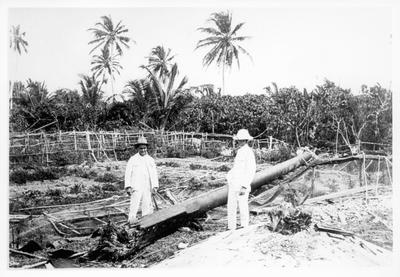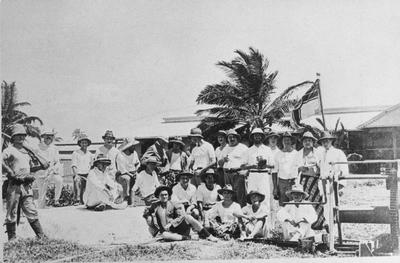

More spectacular was the expansion of the international telegraph network, mainly through the laying of submarine cables (each cable comprising many individual wires). Every major power owned its own commercial network of cables, in time of war these came under either direct government control or close supervision. The technology had also advanced to the point where primitive forms of multiplexer and code compressors were in use to allow a single wire to handle multiple messages. Switching equipment, although fundamentally mechanical, had become complex and expensive. The destruction or damage of an international telegraph station or relay could cause considerable disruption and take a long time to replace (especially if complex equipment had to be transported to it by sea). Such stations thus became important strategic targets in time of war.
Britain with her wide spread empire and trading interests was particularly vulnerable to damage to the cable network, she was, however, well placed to protect her cables and wreak havoc on those of her enemies. Germany had a problem as, for geological reasons, most of her international cables left Europe via the English Channel. As we shall see later she made some alternative arrangements.
On August 4, 1914 Britain opened the telegraph war by cutting the German submarine cable that ran from Borkum in the North Sea to the Spanish island of Tenerife in the South Atlantic. There was a substantial German research station on the coast of Tenerife and there were fears (possibly incorrect) that this was being used as a cover for espionage and potentially for U boat support. As Tenerife lay close to the sea routes that British ships would take to Britain’s West African colonies and South Africa, Winston Churchill (then 1st Lord of the Admiralty) ordered the cutting of the communications link.
The next step was the remaining German cables running through the English Channel. Many of these were simply grappled, raised and cut but some (linking to neutral countries) were patched into the British cable network this providing the Allies with additional capacity (and in the short term probably intercepting incoming messages for Germany from the remote terminus of the cable). Much of Germany’s telegraph connection to the world beyond the Central Powers was destroyed.
Germany struck back, on 7th September 1914 the German cruiser SMS Nurnberg, accompanied by SMS Leipzig under cover of the French flag approached the tiny Pacific territory of Fanning Island. Fanning Island’s only importance was that a submarine cable from Canada came ashore to a cable station provided the switching capacity to route messages to and from two connecting cables, one to Australia and the other to New Zealand. A landing party from the Nurnberg wrecked the station and cut the cables (they also found time to raid the local post office and steal some stamps!).
In November 1914 the crew of the German commerce raider Emden were ordered to destroy the cable station on Direction Island in the Coccos. This station provided a link between Australia and South Africa. On the morning of the 9th the cable station staff saw a warship approaching. Having been warned about SMS Emden the station’s wireless operator sent out a message. "Strange warship approaching" and shortly afterwards "SOS! Emden here" before a German landing party took the station. These messages were picked up by a passing troop convoy and one of the cruisers escorting it peeled off making full speed towards Direction. The cruiser was the HMAS Sidney; within an hour and a half of battle being joined the burning Emden was beached on the nearby North Keeling Island. The landing party managed to cut one cable and wreck some instrumentation before fleeing (they made it back to Germany after 7 months via the Dutch East Indies and Turkey).
Picture 2 Wireless mast destroyed by Germans Direction Island
Picture 1 Telegraph staff under German guard Direction Island
I'm researching my step-mother's grandfather who served as a telegraph operator on Direction Island from 1916. Do you have these photos in higher resolution?
ReplyDelete